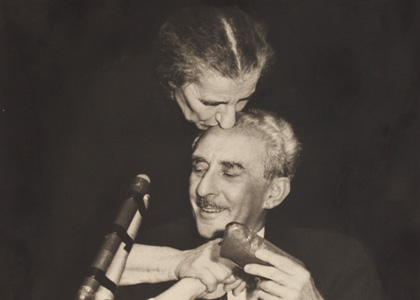Leaders
Sigal Kehat-Krinski
25/03/2010 -
30/10/2010

The exhibition explores the figure of the leader as manifested in Israeli art since the establishment of the State to the present, against the backdrop of the constant political and social changes in our reality. On the one hand, it presents manifestations of the “strong” representative leader as befitting the Zionist ethos: a visionary leader or one who is connected to the essence and roots of the place. These aspects are discernible, for example, in the portrait of the second President, Yitzhak Ben-Zvi, sculpted by Batya Lishansky, the sculpture of Berl Katzenelson by Ya’akov Lutschansky, or the elegant figure of Herzl in Hermann Struck’s print based on a 1903 etching. On the other hand, there emerges the personal, human facet of the leader, who appears before us “in slippers,” so to speak; this is true, for example, of the intimate surprising moment of a kiss between Golda Meir and Moshe Sharett, as captured in Nachman Abramowitz’s lens, or a photograph by an anonymous photographer depicting Ben Gurion holding a lamb in his arms.
The image of the leader, its presentation and marketing, are a prevalent concern among the contemporary artists in the exhibition: thus, for example, in David Reeb’s Security (2002), which blurs Ehud Barak’s figure, or the game of identities between victimizer and victim in a video piece by Boaz Arad, who intermittently assumes the figures of Prime Minister Yitzhak Rabin, and of his assassin, Yigal Amir. The marketing of the leader’s figure as a popular commodity, even its defamation in the form of a wallpaper pattern or an image on a merchantable bank note, is evident in Nurit Sharett’s video work, Identity (2003), which relates to the figure of Moshe Sharett, and in Zeev Engelmayer’s gleaming sequins work (1999), which is a part of a series of portraits made of inexpensive, ornamental materials.
The gap between the leader and his dream, on the one hand, and the harsh reality, the war and its heavy toll, on the other, also arises in some of the works: the image of the Binding of Isaac in Menashe Kadishman’s work—a scaled-down version created especially for the exhibition, of the artist’s well-known sculpture, The Sacrifice of Isaac (1982-85) installed in the concourse of Tel Aviv Museum of Art—or in a photograph portraying Michal Na’aman’s work, The Eyes of the Nation, installed on the Tel Aviv beach in 1972, which set out to protest the ideal of sacrifice and against the establishment which sanctifies power.
Texts and idioms that have become a part of the “silver platter” heritage are at the focal point of other works which undermine biblical myths, proposing a fresh reading of the Zionist myth, among them Michal Na’aman’s A Kid in Its Mother’s Milk (1974) and a New Young Victim (2009), or Shahar Marcus’s video piece The Fathers Have Eaten Sour Grapes and the Children’s Teeth Are Set on Edge (2008) in which the artist assumes the figure of a general, devouring the cookie-decorations on his uniform, only to regurgitate them while reciting Ezekiel’s Vision.
These days, when there is dire need for a head capable of spotting inclinations and introducing a new vision, there is a devaluation of the leader’s figure who comes under increasingly heated criticism from within and from without. These tendencies are manifested in the exhibition, assimilating to the lively public discourse in Israel about leaders and leadership.


